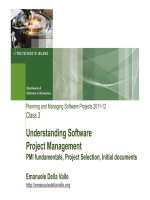Session 5 Scheduling - Software Project Management
Bạn đang xem bản rút gọn của tài liệu. Xem và tải ngay bản đầy đủ của tài liệu tại đây (250.43 KB, 43 trang )
Principles of Project Management, Fa
ll 2008
1
Software Project Management
Session 5: Scheduling
Principles of Project Management, Fa
ll 2008
2
Today
•
Session 4 review
•
Network Fundamentals
•
Gantt Charts
•
PERT/CPM Techniques
•
Mid-term review
Principles of Project Management, Fa
ll 2008
3
Session 4 Review
•
Planning
•
WBS
•
Estimation
•
(Note: NPV, ROI, etc will be covered later in the
term)
Principles of Project Management, Fa
ll 2008
4
WBS
•
Types: Process, product, hybrid
•
Formats: Outline or graphical org chart
•
High-level WBS does not show dependencies or
durations
•
What hurts most is what’s missing
•
Becomes input to many things, esp. schedule
Principles of Project Management, Fa
ll 2008
5
Estimation
•
“The single most important task of a
project: setting realistic expectations.
Unrealistic expectations based on inaccurate
estimates are the single largest cause of
software failure.” Futrell, Shafer, Shafer, “Quality Software Project
Management”
•
Session 4 cont.
Principles of Project Management, Fa
ll 2008
6
Estimation
•
History is your best ally
–
Especially when using LOC, function points, etc.
•
Use multiple methods if possible
–
This reduces your risk
–
If using “experts”, use two
•
Get buy-in
•
Remember: it’s an iterative process!
•
Know your “presentation” techniques
Principles of Project Management, Fa
ll 2008
7
Estimation
•
Bottom-up
•
More work to create but more accurate
•
Often with Expert Judgment at the task level
•
Top-down
•
Used in the earliest phases
•
Usually with/as Analogy or Expert Judgment
•
Analogy
•
Comparison with previous project: formal or informal
•
Expert Judgment
•
Via staff members who will do the work
•
Most common technique along w/analogy
•
Best if multiple ‘experts’ consulted
Principles of Project Management, Fa
ll 2008
8
Estimation
•
Parametric Methods
–
Know the trade-offs of: LOC & Function Points
•
Function Points
–
Benefit: relatively independent of the technology used to develop
the system
–
We will re-visit this briefly later in semester (when discussing
“software metrics”)
–
Variants: WEBMO (no need to know this for exam)
•
Re-Use Estimation
–
See QSPM outline
•
U Calgary
Principles of Project Management, Fa
ll 2008
9
Your Early Phase Processes
•
Initial Planning:
•
Why
–
SOW, Charter
•
What/How (partial/1
st
pass)
–
WBS
–
Other planning documents
»
Software Development Plan, Risk Mgmt., Cfg. Mgmt.
•
Estimating
•
Size (quantity/complexity) and Effort (duration)
•
Iterates
•
Scheduling
•
Begins along with 1
st
estimates
•
Iterates
Principles of Project Management, Fa
ll 2008
10
Scheduling
•
Once tasks (from the WBS) and size/effort (from
estimation) are known: then schedule
•
Primary objectives
•
Best time
•
Least cost
•
Least risk
•
Secondary objectives
•
Evaluation of schedule alternatives
•
Effective use of resources
•
Communications
Principles of Project Management, Fa
ll 2008
11
Terminology
•
Precedence:
•
A task that must occur before another is said to have
precedence of the other
•
Concurrence:
•
Concurrent tasks are those that can occur at the
same time (in parallel)
•
Leads & Lag Time
•
Delays between activities
•
Time required before or after a given task
Principles of Project Management, Fa
ll 2008
12
Terminology
•
Milestones
–
Have a duration of zero
–
Identify critical points in your schedule
–
Shown as inverted triangle or a diamond
–
Often used at “review” or “delivery” times
•
Or at end or beginning of phases
•
Ex: Software Requirements Review (SRR)
•
Ex: User Sign-off
–
Can be tied to contract terms
Principles of Project Management, Fa
ll 2008
13
Terminology
Example
Milestones
Principles of Project Management, Fa
ll 2008
14
Terminology
•
Slack & Float
–
Float & Slack: synonymous terms
–
Free Slack
–
Slack an activity has before it delays next task
–
Total Slack
–
Slack an activity has before delaying whole project
–
Slack Time T
S
= T
L
– T
E
•
T
E
= earliest time an event can take place
•
T
L
= latest date it can occur w/o extending project’s
completion date
Principles of Project Management, Fa
ll 2008
15
Scheduling Techniques
–
Mathematical Analysis
•
Network Diagrams
–
PERT
–
CPM
–
GERT
–
Bar Charts
•
Milestone Chart
•
Gantt Chart
Principles of Project Management, Fa
ll 2008
16
Network Diagrams
•
Developed in the 1950’s
•
A graphical representation of the tasks
necessary to complete a project
•
Visualizes the flow of tasks & relationships
Principles of Project Management, Fa
ll 2008
17
Mathematical Analysis
•
PERT
–
Program Evaluation and Review Technique
•
CPM
–
Critical Path Method
•
Sometimes treated synonymously
•
All are models using network diagrams
Principles of Project Management, Fa
ll 2008
18
MS-Project Example
Principles of Project Management, Fa
ll 2008
19
Network Diagrams
•
Two classic formats
–
AOA: Activity on Arrow
–
AON: Activity on Node
•
Each task labeled with
•
Identifier (usually a letter/code)
•
Duration (in std. unit like days)
•
There are other variations of labeling
•
There is 1 start & 1 end event
•
Time goes from left to right
Principles of Project Management, Fa
ll 2008
20
Node Formats
Principles of Project Management, Fa
ll 2008
21
Network Diagrams
•
AOA consists of
•
Circles representing Events
–
Such as ‘start’ or ‘end’ of a given task
•
Lines representing Tasks
–
Thing being done ‘Build UI’
•
a.k.a. Arrow Diagramming Method (ADM)
•
AON
•
Tasks on Nodes
–
Nodes can be circles or rectangles (usually latter)
–
Task information written on node
•
Arrows are dependencies between tasks
•
a.k.a. Precedence Diagramming Method (PDM)
Principles of Project Management, Fa
ll 2008
22
Critical Path
•
“The specific set of sequential tasks upon
which the project completion date depends”
–
or “the longest full path”
•
All projects have a Critical Path
•
Accelerating non-critical tasks do not
directly shorten the schedule
Principles of Project Management, Fa
ll 2008
23
Critical Path Example
Principles of Project Management, Fa
ll 2008
24
CPM
•
Critical Path Method
–
The process for determining and optimizing the
critical path
•
Non-CP tasks can start earlier or later w/o
impacting completion date
•
Note: Critical Path may change to another as
you shorten the current
•
Should be done in conjunction with the you
& the functional manager
Principles of Project Management, Fa
ll 2008
25
4 Task Dependency Types
•
Mandatory Dependencies
•
“Hard logic” dependencies
•
Nature of the work dictates an ordering
•
Ex: Coding has to precede testing
•
Ex: UI design precedes UI implementation
•
Discretionary Dependencies
•
“Soft logic” dependencies
•
Determined by the project management team
•
Process-driven
•
Ex: Discretionary order of creating certain modules









